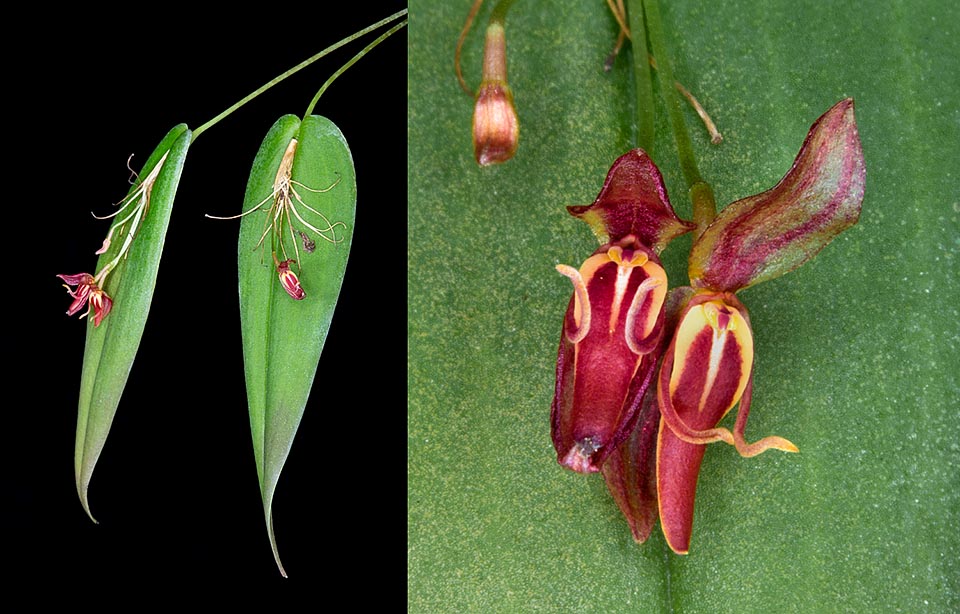Family : Orchidaceae

Text © Pietro Puccio

English translation by Mario Beltramini
The species is native to Ecuador (Imbabura) where it grows epiphyte on the trees of the humid forests at medium altitudes.
After some, the name of the genus comes from the combination of the Greek substantives “πλευρόν” (pleurόn) = rib, nervation and “θαλλός” (thallόs) = stem, with reference to the stems of some species, after others, from “πλευρόν” (pleurόn) = with the meaning of “side” and from the verb “θάλλω” (thallo) = to bloom, with reference to the position of the flowers at the junction between stem and leaf; the name of the species “mastodon” = mastodon, refers to the long curved petals that recall the tusks of this extinct proboscidian.
The Pleurothallis mastodon Luer & Hirtz (1996) is a cespitous epiphytic species with thin close stems, erect, 9-18 cm long, enclosed by two thin tubular sheaths at the base and by another one a little above, provided at the apex of a unique sessile ovate leaf with long pointed apex, 5-8 cm long and 1-2,2 cm broad, coriaceous, of intense green colour. Racemose terminal inflorescence, on a 3-5 mm long peduncle, bearing tiny reddish brown flowers with yellowish margins that open gradually. Oblong-lanceolate dorsal sepal, about 7 mm long and 3 mm broad, lateral sepals united for all their length to form a concave ovate-lanceolate synsepal, 7 mm long and 2,5 mm broad, linear lateral petals curved upward, thin, 6-7 mm long, and oblong-lanceolate fleshy labellum with acute apex, 6 mm long and 2 mm broad.

Native to Ecuador, Pleurothallis mastodon is a small cespitous epiphyte of the humid forests at medium altitude. The stems are thin, with only one 5-8 cm leaf. Racemose inflorescences with tiny and characteristic flowers gradually opening. Protected, is rarely present in the collections of the passionate orchidophiles © Giuseppe Mazza
Floriferous species with characteristic tiny flowers, but rarely present in the collections of the passionate orchidophiles, cultivable in shady position with intermediate temperatures, 20-30 °C in summer, cooler in winter, with lowest values not under the 12 °C, high humidity, 70-80%, and constantly moving air. During the growth period the waterings must be regular and abundant, utilizing rain water, by reverse osmosis or demineralized, but allowing to slightly dry up before watering again, reduced during the period of vegetative rest, without however letting the plant completely dry. It can be cultivated in baskets, but usually is mounted on bark, rafts of cork or of roots of arborescent ferns with a layer of sphagnum at the base to maintain the humidity. Transplants and divisions, when necessary, are to be done by the end of the blooming.
The species is reported in the appendix II of the CITES (species whose trade is internationally ruled).
Synonyms: Acronia mastodon (Luer & Hirtz) Luer (2005); Zosterophyllanthos mastodon (Luer & Hirtz) Szlach. & Kulak (2006).
→ For general notions about ORCHIDACEAE please click here.
